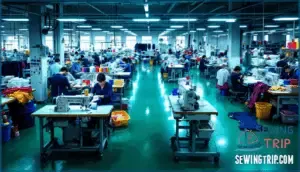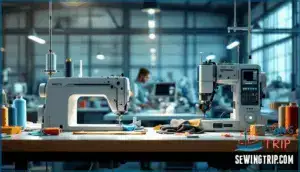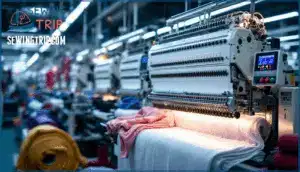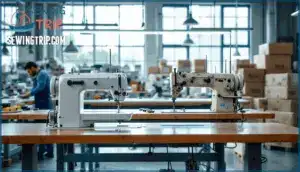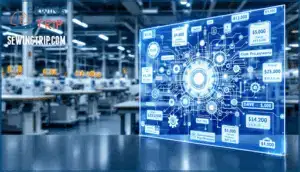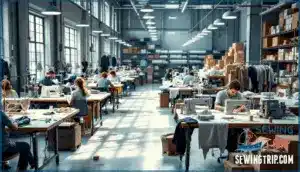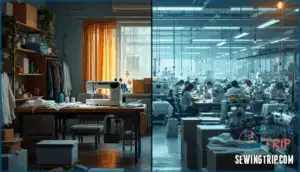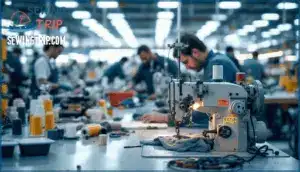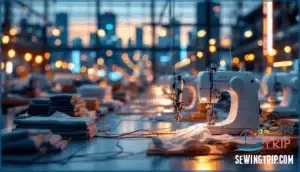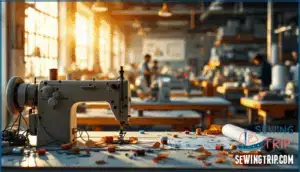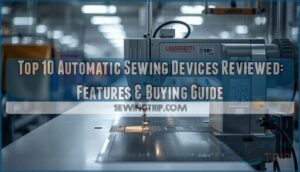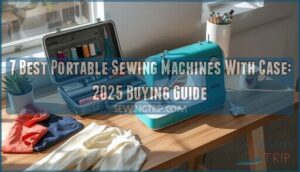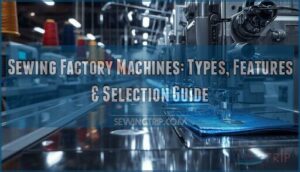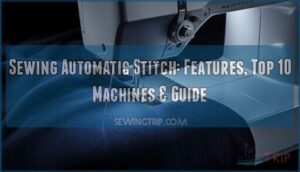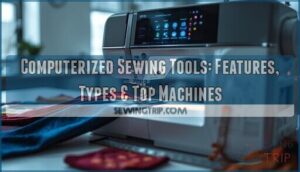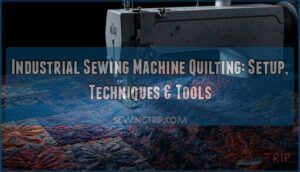This site is supported by our readers. We may earn a commission, at no cost to you, if you purchase through links.
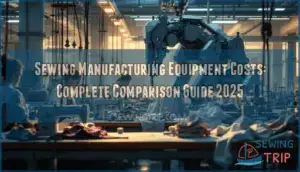
Equipment pricing varies wildly based on machine type, automation level, and production capacity, yet most manufacturers underestimate hidden expenses like installation fees, maintenance allocations, and facility upgrades that can inflate your budget by 25–40%.
This guide breaks down real-world equipment costs across different business models, compares leasing versus buying scenarios, and reveals cost-saving strategies that seasoned operators use to optimize ROI without sacrificing production quality.
Table Of Contents
- Key Takeaways
- Industrial Sewing Machine Types and Costs
- Key Factors Influencing Equipment Pricing
- Cost Breakdown for Garment Manufacturing Setup
- Comparing Equipment for Different Business Models
- Quality, Maintenance, and Long-Term Investment
- Market Trends and Future Outlook
- Cost-Saving Strategies for Equipment Investment
- Frequently Asked Questions (FAQs)
- Conclusion
Key Takeaways
- Industrial sewing equipment demands $50,000+ in initial capital when you factor in hidden costs—installation fees, facility upgrades, and maintenance allocations inflate budgets by 25–40% beyond base machine prices ranging from $1,000 lockstitch units to $150,000+ automated systems.
- Strategic equipment selection hinges on matching automation level to verified production volume: entry-level machines ($1,000–$3,000) suit operations under 500 monthly units, while high-end automated systems ($10,000+) deliver 18–24 month payback periods through 70% reduced manual intervention and sub-2% defect rates at scale.
- Total cost of ownership extends far beyond purchase price—annual maintenance runs 5–8% of equipment value ($500–$4,000 per unit), while energy-efficient upgrades ($15,000–$35,000) and workforce training programs cut operational expenses by 30–40% through reduced downtime and quality failures.
- Smart procurement tactics slash upfront investment: bulk purchasing secures 15–30% discounts, refurbished machines cost 40–60% less than new units, and government incentives—like 100% bonus depreciation and state grants up to $500,000—transform capital expenditure economics for manufacturers willing to navigate available programs.
Industrial Sewing Machine Types and Costs
Selecting the right industrial sewing machine starts with understanding your production requirements and budget constraints. Each machine type fulfills specific garment construction needs, from basic straight seams to complex edge finishing and decorative stitching.
Let’s examine the core machine categories, their capabilities, and what you’ll invest at different performance tiers.
Lockstitch, Overlock, and Coverstitch Machines
You’ll find three workhorses dominating every garment factory floor: lockstitch machines for clean seams, overlock systems that seal edges like armor, and coverstitch units that turn hems into professional-grade finishes.
Each excels at its specialty during the sewing machine manufacturing process. Lockstitch machines deliver superior stitch quality for straight seams, while overlock machines manage fabric control and thread tension for fray prevention. Coverstitch machines combine machine durability with consistent sewing speed for topstitching operations.
Entry-Level Vs. Advanced Automatic Machines
Entry-level industrial sewing machines start around $1,000–$3,000, offering manual controls and speeds up to 3,000 stitches per minute.
High-end automatic machines with machine learning and industrial robotics exceed $10,000 but deliver production optimization through automated sewing capabilities—think 6,000 stitches per minute, predictive maintenance via IoT sensors, and up to 70% reduction in manual intervention.
Automation costs pay back within 2–3 years as sewing efficiency skyrockets and defect rates drop below 2%, transforming the sewing machine manufacturing process for high-volume operations.
The total cost of ownership is also influenced by the industrial sewing machine’s durability and maintenance requirements.
Seamless Machine Technology and Pricing
Continuous knitting machines produce tubular garments—underwear, sports bras, leggings—without side seams, cutting fabric waste by 15–30% while boosting production efficiency.
Continuous machine technology prices range from $25,000 for basic circular knitting units to $150,000+ for multi-gauge computerized systems from top continuous machine manufacturers. Machine upgrades like programmable pattern controls add $8,000–$15,000 but improve ROI through reduced labor and fabric savings.
Cost analysis reveals continuous machine price factors include gauge density, automation level, and software integration—key considerations for your production efficiency targets. Manufacturers should research continuous machine options carefully to find the best fit for their production needs.
New Vs. Used Equipment Cost Comparison
Once you’ve nailed down the machine type and technology level, the next fork in the road is whether to invest in factory-fresh equipment or roll the dice on pre-owned models—a choice that can swing your upfront capital outlay by 40–70%. Here’s how used market trends and cost of ownership stack up:
- Equipment depreciation hits 30–50% in year one for industrial sewing machines
- Refurbishment costs add 10–25% to purchase price but extend machine lifespan
- Warranty comparison shows new units offer 1–3 years vs. 90 days used
- Resale values retain 20–35% after 5 years with proper machine maintenance
- Industrial machine price drops 60% used, making sewing machine investment accessible
Key Factors Influencing Equipment Pricing
You won’t find a simple per-unit price tag that tells the whole story when shopping for sewing equipment. Several interconnected variables determine what you’ll actually pay—and how much value you’ll extract from that investment.
Let’s break down the four primary cost drivers that separate a $1,000 machine from a $20,000 system.
Machine Speed, Durability, and Duty Cycle
When evaluating industrial sewing machines, three critical performance metrics will make or break your production line: stitches per minute, how many years the machine can manage continuous operation, and whether it’s built for light, medium, or heavy-duty cycles.
Speed optimization directly impacts production efficiency—entry-level machines run 3,000–5,000 stitches per minute, while high-end models hit 7,000+.
Durability testing reveals whether equipment setup can sustain three-shift operations without frequent machine maintenance. Heavy-duty cycle ratings protect your cost optimization goals by preventing premature failures that tank performance metrics and drain budgets.
Brand, Country of Origin, and Certification
Brand reputation shapes your equipment investment more than you might expect—top sewing machine manufacturers like Juki, Bernina, and Brother command up to 30% price premiums, but they deliver proven reliability and exceptional quality assurance.
Origin impact matters too: Japanese and German machines cost 20–35% more than Chinese models, yet they retain 70% of MSRP after five years.
Certification costs add 10–18% for ISO 9001 and CE compliance, but regulatory compliance protects you from penalties up to $10,000 annually while boosting reorder rates by 19%.
Included Accessories, Software, and Warranties
Warranty options range from one to five years, with extended support plans adding $500 to $2,000 annually—but they cut downtime by 40% and slash repair costs up to 60%.
Software integration for diagnostics and production tracking justifies its price when you consider accessory kits and maintenance plans together reduce total ownership expenses by 15–25% over a decade.
Automation and Smart Technology Integration
Automation doesn’t just speed up your production line—it fundamentally rewrites the economics of every garment you produce. Artificial Intelligence and smart sensors embedded in computerized control systems boost machine efficiency by 30–45%, while automated cutting and robotic assembly can churn out garments in 22 seconds.
Digital interfacing ties your industrial sewing machines into Industry 4.0 networks, but expect integration costs between $50,000 and $150,000 for full-scale sewing technology upgrades—plus ongoing service contracts starting at $5,000 monthly per unit.
Cost Breakdown for Garment Manufacturing Setup
Setting up a garment manufacturing operation means budgeting for more than just sewing machines. You’ll need to account for facility modifications, supporting equipment, inventory, and training—each with its own price tag.
Here’s what you should plan for in your initial investment.
Equipment Purchase and Installation Costs
You’ll spend between $20,000 and $50,000 on industrial sewing machines and equipment alone—but that’s just the starting line, not the finish.
Installation fees add another 10–15% to your capital investments, covering electrical upgrades, machine calibration, and workforce training.
Don’t forget your maintenance budget—allocate 5–8% annually for upkeep that protects production efficiency and extends equipment lifespan, turning operational expenses into cost-saving strategies that pay dividends.
Facility Improvements and Energy-Efficient Upgrades
Upgrading your production facility isn’t an expense—it’s engineered cost avoidance that slashes operational overhead year after year. Leasehold improvements for production facilities range from $30,000 to $60,000, while energy-efficient lighting and HVAC system installation costs span $15,000 to $35,000. Here’s where your investment delivers measurable returns:
- Energy audits ($2,000–$10,000) identify 10–30% savings potential, with facilities recovering $20,000–$100,000 annually through corrective action
- LED lighting retrofits cut illumination energy use by 20–40% and deliver ROI within 12–18 months
- HVAC upgrades (systems under 10 years old) reduce related consumption by 20–25%, critical since climate control accounts for 19% of textile plant electricity
- Facility insulation improvements lower heating and cooling loads by 8–12%, with payback periods of 2–3 years
Motor efficiency upgrades—including variable frequency drives at $1,100 per machine—save up to 49.4 MWh annually per unit, while high-efficiency motors reduce motor-driven system consumption by 10%.
Water recycling systems and building envelope modifications complete your production facility improvements, aligning operational performance with sustainability mandates while protecting margins against rising utility costs.
Fabric Printing and Eco-Friendly Inventory
While facility upgrades trim your utility bills, sustainable material choices determine whether your production model survives growing regulatory pressure and customer scrutiny.
Eco-friendly fabric inventory stock-up costs range from $10,000 to $25,000, while fabric printing technology investment spans $15,000 to $30,000.
Digital fabric printing equipment delivers on-demand customization without water-intensive fabric dyeing processes, positioning your operation within green manufacturing frameworks that sustainable clothing manufacturing buyers increasingly mandate.
Digital printing and sustainable textiles aren’t compliance theater—they’re margin protection against eco-conscious procurement policies.
Workforce Training and Skill Development
Equipment alone won’t guarantee output—operator competency determines whether your machines run at rated capacity or sit idle behind preventable errors. Staff development and training programs targeting industrial sewing machines and sewing technology fundamentals cut quality control failures by 30–40% while optimizing workforce management systems that directly improve throughput.
Consider these workforce optimization priorities:
- Skill assessment protocols identify capability gaps before they derail production schedules
- Operator certification programs guarantee your team masters lockstitch, overlock, and coverstitch techniques
- Cross-training initiatives build operational resilience when specialized technicians are unavailable
- Continuous improvement workshops keep your workforce aligned with evolving automation standards
Workforce management and training investments protect equipment ROI by preventing costly downtime and rework loops.
Comparing Equipment for Different Business Models
Your equipment needs shift dramatically based on whether you’re stitching custom orders in a spare bedroom or running a factory floor with dozens of operators.
The gap between a home-based operation and industrial-scale production isn’t just about volume—it’s about the type of machinery, space requirements, and capital investment that make sense for your specific model.
Let’s break down how different business approaches demand different equipment strategies.
Home-Based Vs. Factory Production Needs
Choosing between a spare bedroom setup and a dedicated factory floor isn’t just about space—it’s about matching your equipment investment to the reality of your order pipeline and growth trajectory. Home-based operations thrive with compact, entry-level industrial sewing machines optimized for space optimization and lower startup costs, while factory production demands sturdy equipment sizing and industrial equipment investment that accommodates production scaling. Your choice fundamentally shapes cost optimization and production efficiency pathways.
| Factor | Home Factory Setup | Sewing Machine Manufacturing Plant |
|---|---|---|
| Space Requirements | 150–300 sq ft | 2,000–10,000+ sq ft |
| Equipment Investment | $3,000–$15,000 | $50,000–$250,000+ |
| Monthly Throughput | 50–500 units | 5,000–50,000+ units |
Production Volume and Scalability Considerations
Scaling your production capacity hinges on understanding machine capacity and how economies of scale reshape your cost structure. When you jump from 500 to 5,000 monthly units, bulk fabric purchases can drop your material costs by 35%, while production efficiency gains from optimized line configuration slash per-unit labor expenses.
That’s where production planning meets reality: automation benefits accelerate throughput, but scalability barriers—like the 47% of SMEs struggling to justify equipment upgrades—reveal that smart cost optimization isn’t just buying more machines, it’s matching your industrial sewing machines investment to verified order volumes and sustainable manufacturing process improvements.
Customization and Niche Manufacturing Options
Niche markets reward specialization—when your sewing equipment can manage custom embroidery, technical textiles, or small-batch luxury garments, you’re not competing on volume anymore, you’re commanding premium margins that offset higher per-unit machinery costs. Consider how customization scope reshapes your industrial sewing machines investment:
- Tailored apparel lines require multi-needle embroidery units (USD 8,000–15,000) plus custom labels equipment
- Niche textiles like activewear demand specialized coverstitch machines with programmable stitch patterns
- Micro factory setups prioritize production efficiency through modular systems that adapt quickly between orders
Smart cost optimization here means matching equipment maintenance schedules to your customization intensity—frequent changeovers accelerate wear, so factor 15–20% higher annual servicing into your ROI calculations.
Quality, Maintenance, and Long-Term Investment
Your equipment’s upfront cost is just the beginning—what you spend on maintenance, quality control, and operational longevity determines whether you’re building a sustainable operation or bleeding cash. The real question isn’t what machines cost today, but what they’ll cost you over five or ten years of production.
Let’s break down the hidden expenses and long-term considerations that separate smart investments from expensive mistakes.
Maintenance, Repairs, and Replacement Parts
Your maintenance budget can quietly devour profits if you don’t plan for the inevitable wear and tear that comes with high-volume production runs. Machine lubrication, part replacement, and repair scheduling aren’t optional—they’re cost-saving measures that prevent expensive downtime. Track your maintenance costs monthly to spot patterns before breakdowns derail production.
| Maintenance Category | Typical Annual Cost |
|---|---|
| Machine lubrication & cleaning | $500–$1,200 per unit |
| Replacement parts (needles, belts, motors) | $800–$2,500 per unit |
| Scheduled repairs & technician visits | $1,500–$4,000 per unit |
| Emergency downtime & lost production | $3,000–$10,000+ per incident |
Equipment maintenance and upkeep directly impact your bottom line—neglect sewing machine repair, and you’ll pay triple through production delays.
Quality Control Systems and Inspection Equipment
Defects don’t wait for you to notice them—they multiply across production batches and destroy customer trust before you’ve shipped your first order. That’s why fabric inspection equipment and stitch verification systems are non-negotiable investments.
Quality control and assurance audit procedures catch flaws early, protecting your margins. Quality metrics tracked through dedicated inspection equipment prevent defect detection failures that plague industrial sewing machine operations.
Projected Return on Investment (ROI)
Automated sewing systems can deliver a payback period of 18–24 months in high-wage countries, but you need hard numbers—not guesswork. Financial projections based on ROI metrics and cost savings quantify the true investment strategies behind equipment purchases.
- Calculate Payback Analysis using the formula: Purchasing Costs / Annual Net Gains
- Track defect rate reduction and uptime percentage to measure performance impacts
- Monitor Cost Per Garment (total operating cost divided by units produced)
- Account for integration expenses, which add 10–20% to initial investment costs
Market Trends and Future Outlook
You’re investing in equipment at a critical moment—the industry’s shifting fast, and smart money follows the data.
The sewing manufacturing sector isn’t standing still: automation’s accelerating, sustainability’s reshaping sourcing decisions, and regional powerhouses are consolidating their leads.
Understanding where the market’s headed helps you time purchases, capitalize on incentives, and future-proof your operation against tomorrow’s competitive pressures.
Global Market Growth and Regional Dominance
The sewing machine market is expanding globally, with the equipment segment valued at $6.48 billion in 2025 and projected to reach $8.0 billion by 2035. Asia Pacific dominates the competitive landscape with 51.2% market share, driven by China’s industrial sewing machines manufacturing capacity—exporting 1.82 billion units—and economic factors like lower manufacturing costs.
Regional analysis shows North America’s per capita expenditure doubling recently, while supply chain management improvements and government incentives accelerate global expansion across emerging markets.
Demand for Automation and Industry 4.0
Labor shortages and rising wages are pushing manufacturers toward automated sewing systems at record-breaking rates—with demand for smart machines climbing 15–20% annually through 2026 as Industry 4.0 transforms factory floors.
You’ll find AI integration and digital workflows driving production efficiency improvements, while industrial robotics enable cost optimization through faster throughput—robotic lines now complete one T-shirt every 22 seconds.
Smart factories leverage IoT-connected industrial sewing machines for real-time supply chain management and predictive maintenance.
Sustainability and Eco-Friendly Innovations
Green manufacturing isn’t just a buzzword—it’s reshaping the economics of garment production as brands face mounting pressure to cut waste, reduce energy consumption, and prove their environmental credentials to consumers who vote with their wallets.
You’ll need energy-efficient lighting, water recycling systems, and eco-friendly fabric inventory to compete—sustainable clothing manufacturing now demands investment in recycling technologies that transform production waste into reusable materials, cutting costs while meeting regulatory standards for environmental impact.
Government Incentives and Funding Opportunities
Fortunately, government incentives and funding schemes can offset a substantial portion of your capital investments in sewing equipment and automation. You’ll find meaningful financial assistance through:
- Federal Grant Programs – The SBA’s Empower to Grow Program awarded $1.1 million in 2025, while North Dakota’s Automate ND covers up to 50% of automation costs with grants reaching $500,000.
- Tax Incentives and Depreciation Benefits – The One Big Beautiful Bill Act reinstates 100% bonus depreciation for manufacturing equipment, directly cutting your startup cost analysis figures.
- State Equipment Purchase Grants – New Jersey’s Manufacturing Voucher Program offers up to $250,000, and Ohio finances 75% of project costs through Innovation Ohio Loan Fund.
Investment credits and R&D tax offsets make smart manufacturing upgrades financially viable, transforming cost savings from possibility into operational reality.
Cost-Saving Strategies for Equipment Investment
You can’t control equipment costs entirely, but you can control how you buy. Smart purchasing decisions directly impact your bottom line and long-term profitability.
Here’s how to lower your upfront investment without sacrificing production capacity.
Leasing Vs. Buying Industrial Machines
Choosing between leasing and purchasing your industrial sewing equipment isn’t just a financial decision—it’s a strategic move that shapes your operation’s flexibility, cash flow, and long-term competitive positioning.
Leasing preserves capital while spreading ownership costs across predictable rental agreements, though you won’t build equity. Buying delivers tax benefits through equipment depreciation and eliminates ongoing lease options, but demands substantial upfront investment.
Evaluate your production timeline, available machine financing, and growth trajectory to determine which path strengthens your industrial equipment investment.
Sourcing From Authorized Distributors or Refurbished Markets
Once you’ve decided whether to lease or buy, the next critical fork in the road is choosing between authorized distributors who offer factory-backed warranties and the refurbished market where savvy buyers can uncover substantial savings—if they know what to inspect.
Authorized distributor networks provide new industrial sewing machines with extensive warranty comparison advantages, while refurbished options from trusted suppliers offer preowned industrial sewing machine units at 40–60% lower cost factors.
Your supplier evaluation and market research should verify machine duty cycles, test stitching performance, and confirm parts availability before committing to refurbished machines.
Negotiating Bulk Purchase Discounts
When you’re scaling up and ordering multiple units at once, manufacturers and distributors often have room to move on price—but you won’t pocket those savings unless you bring your negotiation game to the table. Wholesale contracts and volume incentives can slash your cost of ownership by 15–30% when purchasing industrial sewing machines.
Your supplier negotiation should leverage bulk pricing benchmarks, request extended warranties, and secure discount strategies that reduce total cost factors while maintaining machine quality and support.
Optimizing Production Efficiency to Lower Costs
Every minute your machines run idle or your operators wait for the next task, you’re watching profit margin evaporate—so tightening up your production workflow isn’t just smart management, it’s a direct line to lower per-unit costs and faster ROI.
Focus on these workflow streamlining tactics:
- Production planning that synchronizes supply chain deliveries with manufacturing process schedules
- Labor optimization through cross-training and task batching to eliminate bottlenecks
- Equipment calibration and preventive maintenance to optimize sewing technology uptime
- Industrial sewing machine selection aligned with actual production volume requirements
Production efficiency and cost optimization compound over time, turning operational discipline into measurable cost savings.
Frequently Asked Questions (FAQs)
How much does a sewing machine cost?
Industrial sewing machine investment varies considerably based on machine type and automation level. Entry-level models start around $1,000–$3,000, while sophisticated automatic systems reach $5,000–$20,000 or higher.
Production costs depend on speed, durability, and smart technology integration, affecting your sewing budget.
How many sewing machines does a sewing department use?
Imagine this: a bustling sewing department with dozens of machines humming simultaneously.
Department size, production capacity, and equipment utilization determine machine allocation—usually ranging from 10 to 100+ industrial sewing machines depending on staffing levels and sewing technology complexity.
How much does a sewing machine maintenance cost?
Maintenance schedules for industrial sewing machines usually cost $500 to $2,000 annually, depending on usage intensity and service contracts.
Warranty options and parts replacement frequency greatly influence repair costs and long-term maintenance expenses for your operation.
What factors affect sewing machine cost?
Machine efficiency, production volume, and quality of materials shape the price range markedly.
Material costs, labor expenses, and market fluctuations also affect smooth machine price factors and cost factors of industrial sewing machines overall.
What makes a sewing machine a billion-dollar company?
Market share and brand loyalty drive revenue streams in the sewing machine market analysis.
Innovation costs fuel global demand for industrial sewing machines and integrated machine technology, transforming manufacturers into billion-dollar leaders through strategic positioning in sewing machine manufacturing plants.
How much does a Brother Sewing Machine cost?
Brother sewing machine pricing spans a wide range: domestic models start around $150–$400, while Brother industrial sewing machines cost $1,000–$5,000+, depending on automation, speed, and specialized features for garment manufacturing operations.
What hidden costs arise during equipment installation and setup?
Beyond equipment purchase and installation fees, you’ll face labor costs for technician setup, training needs for operators, preventive maintenance contracts, facility electrical upgrades, and software integration expenses—often adding 20–35% to your capital expenditure planning and startup cost analysis.
How do tariffs and import duties impact equipment pricing?
Trade policies and duty rates greatly affect your bottom line when sourcing industrial equipment globally. Import fees can add 5–25% to machinery costs, depending on country of origin and classification, making domestic alternatives sometimes more cost-effective despite higher base prices.
What insurance requirements exist for industrial sewing equipment?
You’ll need Equipment Liability and Business Insurance covering industrial sewing machines against damage, theft, and operational risks. Factory Safety Coverage protects workers, while warranties reduce maintenance costs.
Adequate Industrial Risk Management safeguards your equipment purchase investment at any sewing machine manufacturing plant.
How do utility costs vary by machine type?
Your electricity bill tells a story—one where power-hungry lockstitch machines consume 400–800 watts versus 200–500 watts for overlock units. Energy consumption shapes operational costs dramatically, while energy-efficient lighting and HVAC system installation reduce utility savings.
Continuous machine price reflects industrial sewing machines’ power usage demands.
Conclusion
A manufacturer who cuts corners on sewing manufacturing equipment costs often discovers the truth too late: buying cheap means buying twice. Your investment trajectory—whether you’re deploying $15,000 for a modest operation or $200,000 for automated lines—determines your competitive positioning for the next decade.
Strategic equipment selection balances upfront capital against maintenance intervals, production throughput, and energy consumption patterns. Don’t let sticker shock paralyze your decision-making; analyze total cost of ownership, negotiate aggressively with distributors, and structure financing that aligns with your cash flow realities to transform capital expenditure into measurable profit margins.
- https://www.grandviewresearch.com/industry-analysis/sewing-machine-market-report
- https://www.expertmarketresearch.com/reports/industrial-sewing-machines-market
- https://www.fortunebusinessinsights.com/industry-reports/industrial-sewing-machines-market-100613
- https://www.longsew.com/news/automaticindustrialsewingmachineprice-10603.html
- https://www.texspacetoday.com/roi-of-robotic-sewing-where-do-automation-investments-truly-pay-off/

